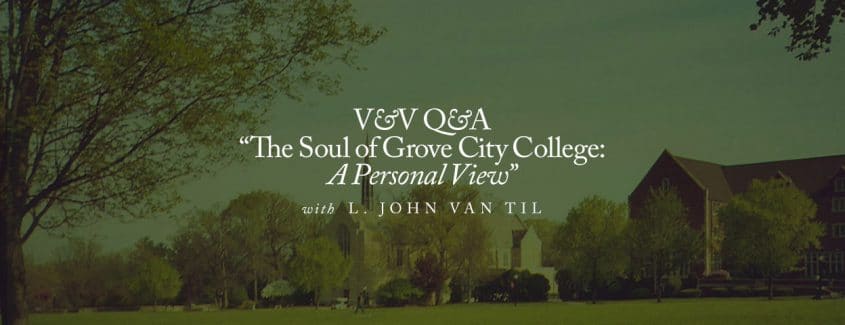
Editor’s note: The “V&V Q&A” is an e-publication from The Center for Vision & Values at Grove City College. In this latest edition, we sit down with retired Grove City College professor L. John Van Til to discuss his new book, “The Soul of Grove City College: A Personal View.”
V&V: Thanks for joining us today, Dr. Van Til. Your book, The Soul of Grove City College: A Personal View, is a fascinating glimpse into your knowledge and time at the college. But it’s not a history and it’s not a journalistic essay. What is it and why write a book about a Christian college in western Pennsylvania?
Van Til: The book reflects the College’s spiritual life as displayed in its intellectual and social development from its founding to recent times. It is based on my experience living with my family on J. Howard Pew’s estate while I researched and wrote speeches for him. In addition, I spent many years of research in college records, and more than four decades working at the College. Writing this account seemed like a valuable exercise for two reasons: To give a much fuller account of who the leading founders were and what they believed and to show how Grove City College is unique among American colleges. It appears to be one of the few Christian colleges that began as a Christian institution and maintained that distinction for more than 100 years.
An unavoidable fact, and thus, a focal point, is the College’s digression from the founders’ Christian vision during the 1950s and 1960s. Board Chairman J. Howard Pew as his last significant decision found a new president and gave him a two-fold charge: Revitalize the intellectual and spiritual life of the College and clean up student social life. It took most of two decades for this mandate to be entirely implemented. The result has been the re-emergence of Grove City College as a vigorous Christian institution. To emphasize, this development has made Grove City College unique in America today—a story worth telling.
V&V: Your book focuses on Grove City but it also highlights a major shift in higher education in America during the 1960s and 70s. Can you tell us a little more about that?
Van Til: There were several crucial changes in higher education in the 1960s and 1970s, which were, of course, part of the context in which Grove City College existed. The most important of these was the radicalizing of college and university campuses. This process had two parts. One was the result of the impact of numerous Marxist professors who began their work, largely unnoticed at the time, in the 1950s. Two examples are Herbert Marcuse and William A. Williams. Such neo-Marxists were hostile to traditional American society and sought to restructure it according to a socialist model. Their efforts were aided by a second element: student-run protests. These efforts included anti-war demonstrations and the “free speech” movement that had many dimensions. Society was profoundly changed by these cultural changes in the 1960s and 1970s.
V&V: How did Grove City College navigate the dramatic cultural change? What did or didn’t change on campus and in the classroom?
Van Til: Grove City College students were not radicalized in the fashion just described. The faculty did have, however, a few “house radicals.” It’s worth noting that a number of students, motivated by the conservative views that emanated from the economics department, militated against the mood of most other campuses, especially in the college newspaper.
Following the loss of accreditation in the mid-1950s, the College moved quickly to hire more than a dozen new faculty. Many of them were trained in the graduate schools that were in the process of being radicalized. It would be inaccurate to suggest that the new hires were hard-core radicals. Yet, it would be accurate to say that their commitment to traditional Christian values was modest.
V&V: What does Grove City College’s past—in its battle for faith and freedom in higher education—portend for its future in an America where higher education and the culture at large reject a faith-based understanding of freedom? Could difficult and even dark times be ahead?
Van Til: Grove City College has long stood for independence and freedom. The freedom theme emerged more fully in the College community as the federal government began to regulate colleges and universities. One result was the famous Grove City College v Bellcase that went to the Supreme Court. Freedom is being attacked in many dimensions of American life. Pew’s famous statement captures the essence of the view of freedom: “From Christian freedom come all of our other freedoms.” If Grove City College maintains this view of freedom, it will continue to be a beacon in higher education.
V&V: Was there anything that surprised you in your research for this book?
Van Til: Soon after my family arrived on campus, we learned that one professor headed a group involved in devil worship—well documented by a professor of religion. At that same time, hostility towards faculty and administration involved in the reformation process was palpable. For instance, late-night voiceless phone calls, interrupting sleep, were made to the homes of the president and dean of students. Later it was found that the calls were made by a young professor. He confessed and admitted that he had been urged on by more senior faculty who opposed the reforms being made.
Looking back, the success of campus-wide spiritual, intellectual, and social reforms has resulted in the outstanding college we have today. The College has an incredible story to tell and surely has been blessed by Providence.
V&V: Thank you for your time, John. We appreciate it. And thanks for sharing your new book with us—it’s definitely worth a read.


